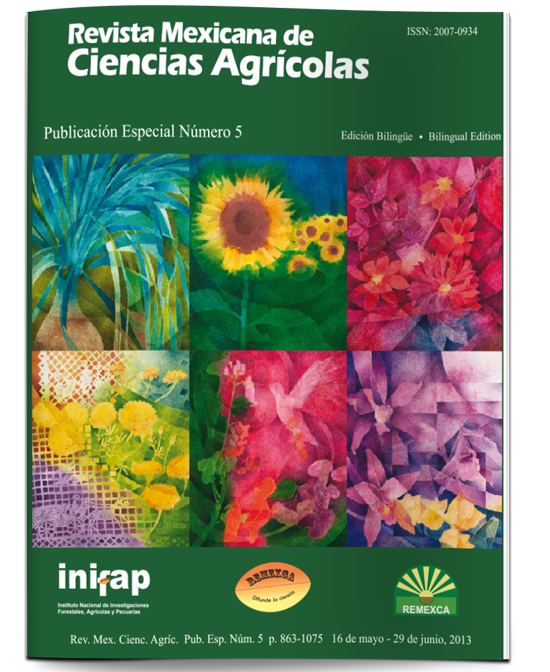Lulo (Solanum quitoense Lamarck.) as a new element of the landscape in Mexico: germination and growth on organic substrates
DOI:
https://doi.org/10.29312/remexca.v0i5.1293Keywords:
Solanaceae, agroecosystems, andean fruits, compost, peatAbstract
We evaluated three different combinations of cachasa compost and peat (T1 40:60 T2 60:40; T3, 80:20, corresponding to relations peat: compost of 1.50, 0.66 and 0.25) on seed germination and seedling growth of lulo (Solanum quitoense Lamarck.), a species that has potential as a landscape element in coffee agroecosystems in Mexico. The research was conducted in the greenhouse with shade cloth during the months of October and November 2012 at an elevation of 650 masl, at 18° 50” north latitude and 96° 51" W, in a place with 18.4 °C annual average temperature and 78% Relative Humidity. The experimental design was completely randomized with four replications. Comparison of means was done by Tukey test (p≤ 0.05). The highest percentage of seed germination and increased root development was observed in the treatment T3 (80% compost; relationship peat: compost of 0.25), although this treatment also recorded lower plant height, stem diameter, size leaves and SPAD units. Higher average values in plant height, stem diameter, length and width of leaves were recorded in T1 and T2 (p≤ 0.05). Lulo seeds can germinate and produce healthy seedlings exposed to experimental conditions in relations peat: compost between 1.50 and 0.66, corresponding to 40 and 60% compost in the substrate, while the relationship peat: compost of 0.25 increases seedling germination but produces lower quality for transplantation.
Downloads
Downloads
Published
How to Cite
Issue
Section
License
The authors who publish in Revista Mexicana de Ciencias Agrícolas accept the following conditions:
In accordance with copyright laws, Revista Mexicana de Ciencias Agrícolas recognizes and respects the authors’ moral right and ownership of property rights which will be transferred to the journal for dissemination in open access. Invariably, all the authors have to sign a letter of transfer of property rights and of originality of the article to Instituto Nacional de Investigaciones Forestales, Agrícolas y Pecuarias (INIFAP) [National Institute of Forestry, Agricultural and Livestock Research]. The author(s) must pay a fee for the reception of articles before proceeding to editorial review.
All the texts published by Revista Mexicana de Ciencias Agrícolas —with no exception— are distributed under a Creative Commons License Attribution-NonCommercial 4.0 International (CC BY-NC 4.0), which allows third parties to use the publication as long as the work’s authorship and its first publication in this journal are mentioned.
The author(s) can enter into independent and additional contractual agreements for the nonexclusive distribution of the version of the article published in Revista Mexicana de Ciencias Agrícolas (for example include it into an institutional repository or publish it in a book) as long as it is clearly and explicitly indicated that the work was published for the first time in Revista Mexicana de Ciencias Agrícolas.
For all the above, the authors shall send the Letter-transfer of Property Rights for the first publication duly filled in and signed by the author(s). This form must be sent as a PDF file to: revista_atm@yahoo.com.mx; cienciasagricola@inifap.gob.mx; remexca2017@gmail.
This work is licensed under a Creative Commons Attribution-Noncommercial 4.0 International license.



